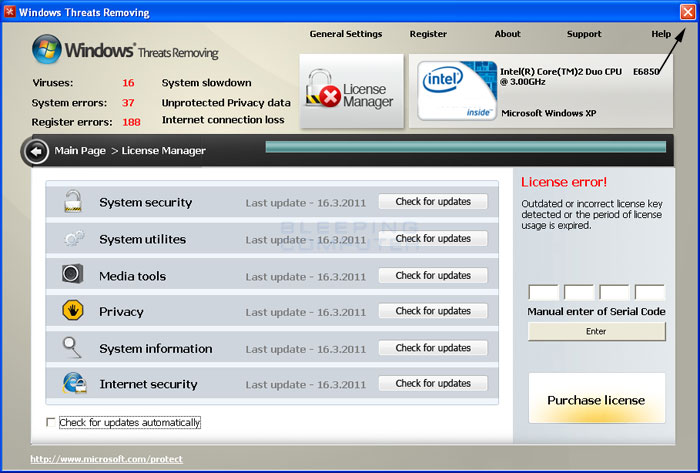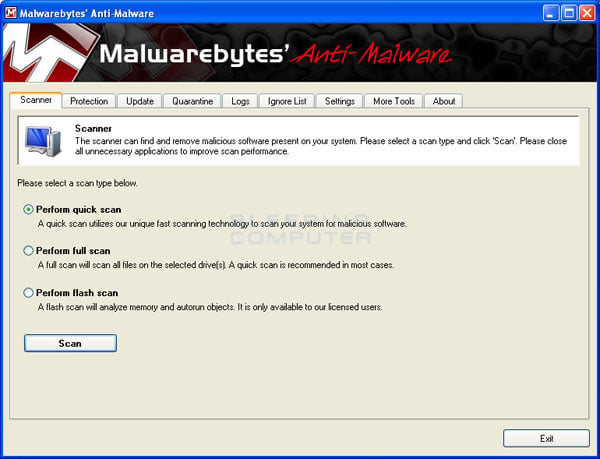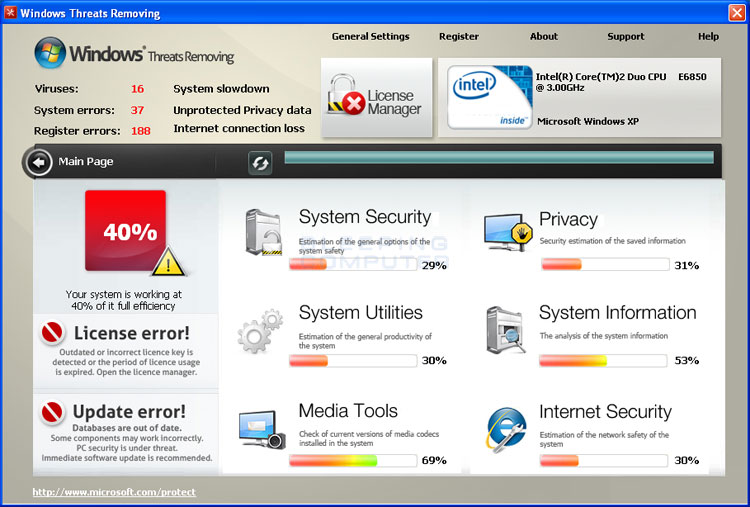Windows Threats Removing is a fake rogue anti-spyware program that is part of the Fake Microsoft Security Essentials infection. When this infection is installed on your computer it will display a fake Microsoft Security Essentials alert that states that it has detected an Unknown Win32/Trojan on your computer. This alert will state:
Microsoft Security Essentials AlertIt will then prompt you to scan your computer, which will start a fake scan of your computer that ultimately states that a particular file is infected with Trojan.Horse.Win32.PAV.64.a. It will then prompt you to install Windows Threats Removing to remove the virus. The text of this prompt is:
Potential Threat Details
Microsoft Security Essentials detected potential threats that might compromise your private or damage your computer. Your access to these items may be suspended until you take an action. Click 'show details' to learn more.
Threat prevention solution foundWhen you press OK, the infection will download and install Windows Threats Removing and reboot your computer.
Security system analysis has revealed critical file system vulnerability caused by severe malware attacks.
Risk of system files infection:
The detected vulnerability may result in unauthorized access to private information and hard drive data with a seriuos possibility of irreversible data loss and unstable PC performance. To remove the malware please run a full system scan. Press 'OK' to install the software necessary to initiate system files check. To complete the installation process please reboot your computer.
When your computer reboots you will be presented with the Windows Threats Removing screen before your normal Windows desktop is shown. It then prompts you to scan your computer, which will state that your computer is infected with numerous infections. In order to get to your normal Windows desktop, you will need to close the Windows Threats Removing program when it has finished its fake scan. As you can see this program is a scam as it is ransoming the proper operation of your computer until you purchase it. It goes without saying that you should not purchase this program for any reason.
While the program is running it will also display fake security alerts that are further used to scare you into thinking that your computer has a serious problem. Some of these alerts include:
System Security WarningJust like the fake scan results, these alerts are also fake and are only being used to scare you into purchasing the program. Therefore, please ignore them.
Attempt to modify register key entries is detected. Register entries analysis is recommended.
System component corrupted!
System reboot error has occurred due to lsass.exe system process failure.
This may be caused by severe malware infections.
Automatic restore of lsass.exe backup copy completed.
The correct system performance can not be resumed without eliminating the cause of lsass.exe corruption.
Warning!
Name: firefox.exe
Name: c:\program files\firefox\firefox.exe
Application that seems to be a key-logger is detected. System information security is at risk. It is recommended to enable the security mode and run total System scanning.
As you can see, Windows Threats Removing was created to scare you into thinking your computer has a severe security problem so that you will then purchase this program. For no reason should you purchase Windows Threats Removing, and if you already have, you should contact your credit card company and dispute the charges stating that the program is a computer infection. Finally, to remove this infection, and any related malware, please use the removal guide below.
Threat Classification:
Advanced information:
View Windows Threats Removing files.
View Windows Threats Removing Registry Information.
Tools Needed for this fix:
Guide Updates:
03/16/11 - Initial guide creation.
Automated Removal Instructions for Windows Threats Removing using Malwarebytes' Anti-Malware:
- Print out these instructions as we may need to close every window that is open later in the fix.
- It is possible that the infection you are trying to remove will not allow you to download files on the infected computer. If this is the case, then you will need to download the files requested in this guide on another computer and then transfer them to the infected computer. You can transfer the files via a CD/DVD, external drive, or USB flash drive.
- The Windows Threats Removing infection will start before your normal Windows desktop appears. To access your desktop we first need to allow it to perform it's fake scan. Therefore, when it tells you that it must perform a scan press the OK button to allow it to do so. Windows Threats Removing will now perform a fake scan and then state you need to open the License Manager. Press the OK, Open the license manager button. You will now be at a screen where you can close the program by clicking on the X at the top right of the Windows Threats Removing Window. Shown below is an image of the program screen that shows the location of the X, designated by the black arrow, that you should click on to close the program. Once you close the program, your Windows Desktop will load normally.

Now that your Windows Desktop is available, we can continue with the rest of the removal process.
- Before we continue we should also terminate the Windows Threats Removing infection so that it does not interfere with the cleaning procedure. To do this, please download RKill to your desktop from the following link.
RKill Download Link - (Download page will open in a new tab or browser window.)
When at the download page, click on the Download Now button labeled iExplore.exe download link. When you are prompted where to save it, please save it on your desktop.
- Once it is downloaded, double-click on the iExplore.exe icon in order to automatically attempt to stop any processes associated with Windows Threats Removing and other Rogue programs. Please be patient while the program looks for various malware programs and ends them. When it has finished, the black window will automatically close and you can continue with the next step. If you get a message that RKill is an infection, do not be concerned. This message is just a fake warning given by Windows Threats Removing when it terminates programs that may potentially remove it. If you run into these infections warnings that close RKill, a trick is to leave the warning on the screen and then run RKill again. By not closing the warning, this typically will allow you to bypass the malware trying to protect itself so that RKill can terminate Windows Threats Removing . So, please try running RKill until the malware is no longer running. You will then be able to proceed with the rest of the guide. Do not reboot your computer after running RKill as the malware programs will start again.
If you continue having problems running RKill, you can download the other renamed versions of RKill from the RKill download page. All of the files listed there are renamed copies of RKill, which you can try instead. Please note that the download page will open in a new browser window or tab.
- Next we have to do is fix your Windows Registry Shell value. If we do not fix this entry and is deleted, then your Windows desktop will not be displayed the next time you reboot.
To fix the Shell entry, simple download the following file to your desktop. If you are having trouble downloading the file, try right-clicking on it and selecting Save as.
Shell.reg Download Link
- Once Shell.reg has been downloaded, locate it on your desktop and double-click on it. When Windows asks if you would like the data to be merged, please allow it to do so.
- Now you should download Malwarebytes' Anti-Malware, or MBAM, from the following location and save it to your desktop:
Malwarebytes' Anti-Malware Download Link (Download page will open in a new window)
- Once downloaded, close all programs and Windows on your computer, including this one.
- Double-click on the icon on your desktop named mbam-setup.exe. This will start the installation of MBAM onto your computer.
- When the installation begins, keep following the prompts in order to continue with the installation process. Do not make any changes to default settings and when the program has finished installing, make sure you leave both the Update Malwarebytes' Anti-Malware and Launch Malwarebytes' Anti-Malware checked. Then click on the Finish button. If MalwareBytes' prompts you to reboot, please do not do so.
- MBAM will now automatically start and you will see a message stating that you should update the program before performing a scan. As MBAM will automatically update itself after the install, you can press the OK button to close that box and you will now be at the main program as shown below.

- On the Scanner tab, make sure the the Perform full scan option is selected and then click on the Scan button to start scanning your computer for Windows Threats Removing related files.
- MBAM will now start scanning your computer for malware. This process can take quite a while, so we suggest you go and do something else and periodically check on the status of the scan. When MBAM is scanning it will look like the image below.

- When the scan is finished a message box will appear as shown in the image below.
You should click on the OK button to close the message box and continue with the Windows Threats Removing removal process.
- You will now be back at the main Scanner screen. At this point you should click on the Show Results button.
- A screen displaying all the malware that the program found will be shown as seen in the image below. Please note that the infections found may be different than what is shown in the image.

You should now click on the Remove Selected button to remove all the listed malware. MBAM will now delete all of the files and registry keys and add them to the programs quarantine. When removing the files, MBAM may require a reboot in order to remove some of them. If it displays a message stating that it needs to reboot, please allow it to do so. Once your computer has rebooted, and you are logged in, please continue with the rest of the steps.
- When MBAM has finished removing the malware, it will open the scan log and display it in Notepad. Review the log as desired, and then close the Notepad window.
- You can now exit the MBAM program.
- As many rogues and other malware are installed through vulnerabilities found in out-dated and insecure programs, it is strongly suggested that you use Secunia PSI to scan for vulnerable programs on your computer.


No comments:
Post a Comment